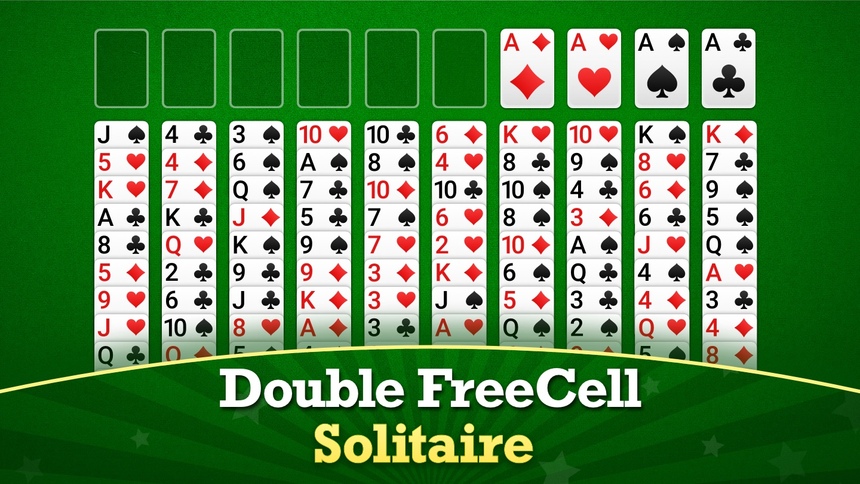Double FreeCell in a Nutshell

Double FreeCell takes the classic FreeCell card game, beloved by many for its blend of skill and strategy, and doubles the challenge and excitement. Utilizing two decks of cards instead of one, Double FreeCell offers solitaire enthusiasts more complex layouts and the opportunity for deeper strategy. Double FreeCell is perfect for those who find traditional version a bit too predictable or who simply seek a more mind challenging card game experience.
Objective of the Double FreeCell
The objective in Double FreeCell is much like that of the classic version: to build up all cards on the foundation piles, sorted by suit from Ace to King. However, with two decks, players must complete two full sequences of each suit, doubling the mental effort needed for clearing the board. This game is ideal for seasoned solitaire players who enjoy a longer, more thought-provoking challenge.
How to play FreeCell with 2 decks: Double FreeCell Rules
Playing Double FreeCell requires strategic foresight and careful planning. Here’s how you can master this engaging game:
Layout: Start by dealing 104 cards into ten tableau columns. The first four columns contain 11 cards each, and the remaining six contain 10 cards each, all facing up.
Tableau Columns: In Double FreeCell, all cards in the tableau columns are displayed face-up, but only the topmost cards are immediately movable. To access and utilize the other cards in the tableau, you must strategically rearrange them. Cards can be moved between columns in descending order by alternating colors; for instance, a red 6 can be placed on a black 7. Typically, only single cards can be moved from one column to another unless additional space is available. The ability to move a sequence of cards depends on the number of free cells and empty tableau columns you have at your disposal. For example, having one free cell allows you to move two cards together as a sequence, while two free cells enable the movement of three cards, and so on. This rule is crucial for effectively managing the tableau and preparing cards for eventual placement into the foundations.
Free Cells: Double FreeCell provides six free cells, where any single card can be temporarily stored. These cells are crucial for maneuvering around the tableau, allowing you to access and rearrange cards effectively.
Foundations: Build the four foundation piles organized by suit, starting from Ace to King. Since there are two decks in Double FreeCell, each suit will have two complete sequences within the foundations. This means you will place an Ace of each suit at the base of a foundation, followed by all subsequent numbers up to the King, then repeat the sequence, starting again with an Ace and finishing with a King.
What is the difference between Classic FreeCell and Double FreeCell?
While Classic FreeCell involves a single deck and typically has four free cells, 52 cards and four foundation piles, Double FreeCell expands almost every aspect of the game:
- Decks Used: Double FreeCell uses two decks, or 104 cards, hence the name 'Double'.
- Tableau Columns: Increases from eight in Classic FreeCell to ten.
- Free Cells: Increases the number from four to six, providing more strategic options for storing cards temporarily.
- Foundation Piles: the number of piles is still 4, but each of them requires to be wrapped by two complete sequences of cards of the same suit.
Double FreeCell not only offers a greater challenge but also demands more intense concentration and strategic planning, making it a perfect choice for those who enjoy playing FreeCell 24/7. It's an excellent way to sharpen your mind or kill some time, proving that more is sometimes better in the world of card games.

